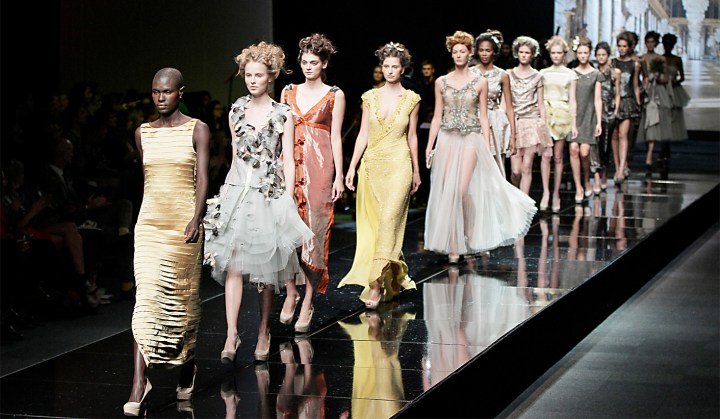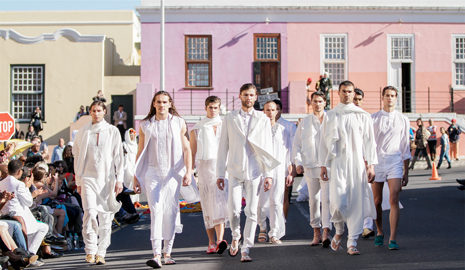Maverick Life
Chronicles of chic: Fashion week, fashion weak

Fashion is a merciless fairy-tale; from the small, often ignored studios of designers to the ruthless universe of retail, the competition is uncompromising and the reigning masters are few. Defined by the fashion weeks’ rigorous calendar, from New York to Paris or Milan, the world of what’s en vogue starts on the catwalks of four major fashion capitals. For a while, Cape Town's been trying to join the party, with mixed results. By EMILIE GAMBADE.
Fashion Weeks are used to showcase the latest collections of inspiring designers around the world; usually split according to Prêt-à-Porter, Couture/ Haute Couture and Spring/ Summer, Autumn/ Winter, the pace is fast and the competition fierce. Magazine editors – the omni-powerful Anna Wintour front-row – local and international buyers, wealthy clients and VIPs of the day attend, hungry and demanding. It’s festive, fast and furious; it’s grandiose and emotional. Every faux pas is eagerly caught and reported by the press and enjoyed by the competitors.
On the 6th of September, New York kicks off the round of fashion weeks, followed by London, Milan and Paris. Months before the shows, prominent fashion houses, owned by Louis Vuitton Moët Hennessy (LVMH), Richemont, Chanel SA and consorts, send their designers or close assistants across the world in order for them to build up their imaginary and mood boards.
For as long as designers could dream, the translation of their inspiration, mainly fed through travels (across the oceans, real or imagined), readings and cross cultural sharing, gives birth to a collection, a mix of traditions and local workmanship; designers are final storytellers, writing with the tip of their scissors, silent lips and magic hands.
In 1947, Christian Dior returned from a trip to the US and drew a collection inspired by the city of New York. Kim Jones, Louis Vuitton’s men style designer, recently used the Maasai traditional Shuka in his Spring/ Summer 2012 collection, some raising their voices to the ‘unashamed’ steal, while others praised his clever references to the bright blue and red decorative African fabric.
A collection tells a story of garments, shoes, hairstyles, makeup and accessories; the power of international fashion houses and their famous designers lies in their ability to write the tales of clothes and an ability to pull women and men into their world, glimpses of exotic places and faraway travels strongly embedded in their unique craftsmanship and savoir-faire.
The story-telling part is essential; a collection must have a meaning, the same way a painting, a sculpture is not done by chance, but the reflection of the artist’s mind; it is the mirror of someone’s very own creative intimacy, an attempt to embellish, dress the human body, turn it into a window to a new world of textures, cuts, tailoring and colours.
Collections showcased at international fashion weeks typically encompass around twenty looks, worn by carefully selected models, focused by an edgy music, the whole spectacle set in a location that should be fitting it like a glove.
Consistently, Africa inspires international designers and covers the pages of international magazines; splashes of warm tones and animal prints, hair like hens lost in the sand. The result, although a combination of western designs created by western hands for the western eye in search of faraway travels and motherland calling, is often beautiful, outrageous; it screams eternal sunshine and colourful fabrics, gold jewellery shining on the arms, heavy bangles worn like armours; African images on international catwalks seems rooted in the Serengeti or the vast lands of the Kruger Park, bright diamonds, ostrich feathers, zebra prints and leather skins symbols of an Africa very à la mode.
But what does Africa look like on South African catwalks? If it is anything similar to what was recently shown on the stages of the Cape Town Fashion Week (CTFW), then the Devil itself is reluctant to wear local.
Twenty-six local designers were presenting, over four days, what South Africa does best in terms of fashion design. Strictly speaking, it should be a proud display of local cutting, tailoring, trimming, all translated into a series of dresses, pants, blouses, shoes etc; and it should be, as Dr Precious Moloi-Motsepe, the director of African Fashion International (AFI) that held the fashion week in Cape Town, explained, “saleable”.
Saleable, because if produced locally, from Cut, Make and Trim (CMT) to retail, a collection can generate a considerable income and be an economic driving force; the 2011 Annual Report of the French National Conference for the Industry (CNI), commissioned by the Ministry of Industry, states that the fashion and luxury industry in France employs 130,000 people with an annual turnover of 34 billion euros; around the globe, the fashion industry was worth 181 billion euros in 2011.
Now, the recipe applies if a substantial part of the production happens locally, else the soufflé falls flat; in South Africa, the CMT sector is almost non-existent as the textile-manufacturing industry has dropped from highly competitive to barely surviving. Dr Moloi-Motsepe says, “As a country we have suffered a step back; we’ve lost quite a lot of textile mills, a bit of manufacturing because of the competition of cheaper imports that flooded our country.”
Does it affect what’s presented on the catwalks? Maybe, as the lack of sumptuous fabrics, perfectionism in detailing and consistency seems to be a repetitive pattern throughout the collections presented at the CTFW; and it is sabotaging an industry nonetheless blessed by unsung talents and bright ideas. It is clear that a fashion week makes sense, evident that creativity and imagination is blooming, obvious too that the designers – at least the majority of them – have worked hard and gained confidence over the years.
If the event has been growing consistently for the past ten years, the collections still do not shout attention to detail, understanding of exacting proportions or authority built through a carefully designed education system; rather, they speak of a last-minute show thrown onto the big stage to the barely-bearable beat of dance music.
There were some gems in the rough, still. Gavin Rajah handled the Dolce Vita cruise look with a confident hand; his collection reflected the 1950s with panelled dresses, bra corsets, darts on the waist line and sequined boleros all in splashes of pinks and zests of lemon; sported cowboy jackets had embroidered shadows of Fabergé eggs, while flowery blouse atop elegant high-waist wide-leg pants underlined a lanky silhouette; this was serious chic.

Photo: Gavin Rajah, CTFW 2012, Simon Deiner/SDR Photo
David Tlale’s decision to bring his collection to Rose Street, BoKaap, was refreshing and inviting; the colourful houses were a contrasting backdrop for his very white production of garments. His story, no matter the monotonous cuts and the tedious drapery, was an invitation to silence, slowness and spirituality, a rather interesting take on an otherwise frantic week; the curlers in his models’ hair added some roundness to the angular scenery while the tribal makeup and geometric patches of white paint enhanced the simplicity of the clothes.
Other highlights included the charming Cape Philharmonic Youth Orchestra performance at Stefania Morland’s show and her palette going decrescendo, from bright orange to pale flesh-coloured garments; Kluk CGDT audacity; Lalesso’s daring headpieces and a concerto of adventurous, carefully put together, inspiring styles worn by fashionistas just outside the shows.

Photo: David Tlale in the Bo-Kaap, CTFW 2012 (Simon Deiner/SDR Photo)
Dr Moloi-Motsepe states, “We have to make sure to integrate a pool of designers that are really spectacular and are using unique African designs and bring something different on the global fashion market; not really reproducing what other Europeans or international designers are doing but using local references and doing something that is uniquely African and saleable everywhere in the world.”
But here’s the thing: the pool of designers chosen for this CTFW might have produced “unique” collections or succeeded in being “saleable”, but there was still no real fabric, there were no cut mavericks, no playful takes on texture; there was no one who brought South African fashion into a new era, created an inspiring silhouette or told a story that was really purposeful. This is not because the country lacks talent, but when Stefania Morland presents skirts with hanging threads and garments that clearly have not been ironed, it does not shine a pretty light on the whole industry. And yes, it may be her signature, but it is not a desirable one.
Fashion weeks around the world, led by New York, Paris, London and Milan, set the bar high; to join the elite world walking the catwalks, designers have to fit the brief without beating around the bush. South Africa, through the lens of the CTFW, seems to be slightly more lenient in its selection process. The next fashion week will be in Johannesburg, from 28 to 30 September, organised this time by South African Fashion Week. It will present another set of designers; and with five fashion weeks in total, jutting out Italy and France, South Africa provides more platforms for designers to showcase their work than the main fashion capitals – long forgotten the blessed principle of less is more.
To be uniquely African is a vast concept; from cherishing local workmanship and its instrumental value to embracing the incredible richness of our cultural diversity, there is a lot to feed designers’ creativity and distinctiveness; but it takes time to channel one’s imagination into a perfect dress, to master the art of cutting, to create a collection like the culmination of one’s talent; till then, a less sybaritic fashion week would be welcome. As Anna Wintour once said, “You either know fashion or you don’t.” And if you don’t, try to avoid showing it off on a catwalk. DM
Main photo: Stefania Morland at CTFW 2012 (Simon Deiner/SDR Photo)



















 Become an Insider
Become an Insider